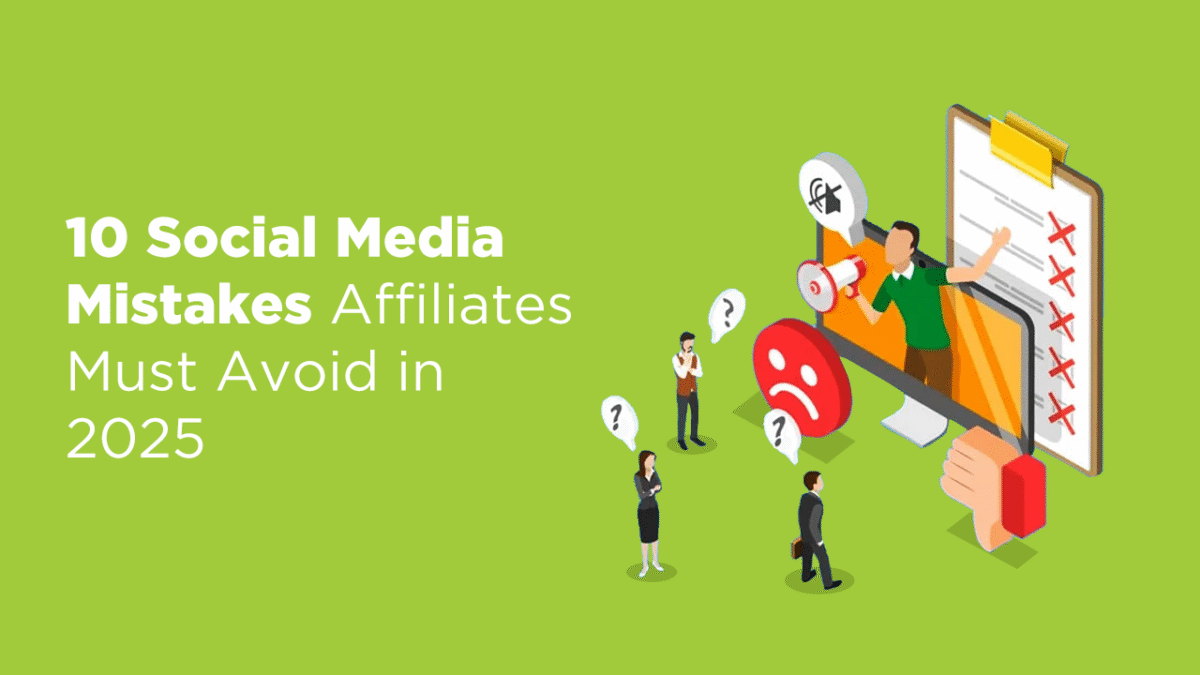
As an affiliate, you run a campaign on social media. It gets a few likes. You add a trending song. The views go up, but clicks? Still flat. This is the trap many affiliates fall into in 2025: mistaking reach for results. Social media is crowded, fast, and constantly shifting. But if you know what not to do, it can become a powerful conversion channel. The trick isn’t just showing up, it’s showing up smart.
And the stakes are high. 81% of brands are now using affiliate programs to boost both sales and awareness, according to Statista’s 2025 Affiliate Marketing Report. That means more competition and higher expectations, from brands and users alike.
You don’t need a massive following to win. You just need to stop making the small mistakes that cost you big. Let’s break down the top 10 social media mistakes affiliates must avoid this year, and what to do instead.
If you’re posting the same creative with the same caption across Instagram, Telegram, Facebook, and YouTube Shorts, PAUSE.
Each platform has its own pace, audience behavior, and content style. What clicks on Telegram (flashy discount, quick link, short CTA) may flop on Instagram, where storytelling and visuals drive engagement. YouTube Shorts needs a strong hook in the first 2-3 seconds, while Facebook still responds to long-form captions and share-worthy deals.
By copy-pasting across channels, you risk blending into the noise or looking out of place.
Adapt your content format and tone based on the platform. Use Instagram for reels, swipe-throughs, and aesthetic product stories. Telegram and WhatsApp work well for urgency-based deals. YouTube Shorts? Keep it fast, visual, and value-packed.
Platform-specific content doesn’t mean more work; it means smarter strategy.
Dropping a coupon code in every post might seem like a smart push, but it becomes digital noise without context.
Users are bombarded with discounts all day. If your post just says “Use coupon code ABC123 to get 20% off,” without telling them why this product matters or how it fits into their life, they’ll scroll past. Even worse, your feed can start looking more like a classified ad than a trusted source.
Lead with value. Explain the product’s use, share a personal win, or tie it to a trend (“Here’s what helped me manage oily skin this summer”). Then drop the code as a bonus, not the headline. When the offer feels like a reward for staying till the end, rather than the only reason to click, conversions naturally go up.
Sometimes your reach drops, not because your content is bad, but because the platform is silently penalizing you.
Affiliates often overlook platform-specific rules. For example, they could be using too many hashtags, posting misleading thumbnails, or overusing outbound links. These violations can trigger shadowbans, which means their content stops appearing in feeds, searches, or explore pages without any official warning. On Facebook, especially, violations can quickly snowball into account restrictions or full blocks.
Instagram and TikTok also have sensitive algorithms. On top of that, some affiliates post adult content, restricted product categories, or promote in ways that don’t meet community standards.
Stay updated with the platform’s latest guidelines. Avoid clickbait or deceptive captions. Always disclose affiliate partnerships when required. Use link-in-bio tools or shortened links carefully, and don’t spam your audience with back-to-back promotions.
A clean, consistent approach builds long-term trust, with both your followers and the platform.
If your feed only comes alive when there’s a deal to push, your audience will start tuning out. Fast.
Social media thrives on connection and consistency. When followers see that you only show up during flash sales or cashback events, it signals that you’re here to promote, not to engage. That hurts credibility and reduces the performance of even your best campaigns.
Also, platform algorithms reward regular posting. Long gaps in activity can cause your future posts to get less visibility, even if they’re important ones.
Keep your content flowing between campaigns. Share user feedback, product comparisons, behind-the-scenes content, industry trends, or personal tips. Not everything needs to be a hard sell.
Build a content rhythm that keeps your audience warm. That way, when you do drop an offer, it lands on a feed that’s already active and engaged.
“Buy now!” “Hurry, last chance!” “Don’t miss out!” These lines might work on a push notification or SMS, but they fall flat on platforms like Instagram or Pinterest.
Affiliates sometimes bring a high-pressure sales tone into soft-sell environments, where users are looking to scroll, explore, or get inspired, not to be sold to immediately. This mismatch can feel intrusive and cause followers to disengage.
People don’t log into Instagram to see offers; they stay for stories, aesthetics, and experiences. If every post screams urgency without any narrative, you risk losing trust and reach.
Match your tone to the platform. Use storytelling, personal reflections, or trend tie-ins to introduce your offer. Try lines like “Here’s what’s helped me lately” or “This is a game-changer I didn’t expect.”
Soft-sell platforms reward subtlety. Use it to your advantage.
If you’re just posting and hoping for the best, you’re not marketing, you’re guessing.
Many affiliates focus on publishing more content, but forget to analyze what that content is actually doing. Which platform drives the most clicks? Which reel got saves but no conversions? Are people dropping off before they reach your link? These are questions that can guide smarter decisions, but only if you’re tracking the right metrics.
Relying on likes alone can be misleading. A post with fewer likes but more click-throughs might be far more valuable than a viral reel with no sales.
Use platform insights (Instagram, Telegram analytics, etc.) and your affiliate dashboard to monitor key performance indicators, clicks, conversions, bounce rates, time of day, and content type.
Small adjustments based on data often lead to big results. Guess less, optimize more.

If your creatives look great on a desktop but are cluttered on a phone, you’re missing the mark.
Over 99% of social media users access platforms via mobile devices according to Sprinklr. Yet some affiliates still post horizontal videos, tiny-text screenshots, or captions that get cut off halfway. These small formatting issues can silently kill your reach and response.
People scroll fast. If your content doesn’t grab attention within seconds on mobile, it’s likely to be ignored, even if the offer is solid.
Design for vertical screens. Use a 9:16 aspect ratio for videos and reels, keep text big and readable, and test your posts on your own phone before publishing. Make sure your CTA and link are visible above the fold.
Mobile-first isn’t just a design choice, it’s a conversion strategy.
Every unanswered comment is a missed opportunity. Every ignored DM is a potential conversion slipping away.
Affiliates often focus so much on pushing content that they forget to listen. But engagement is a two-way street. When someone takes the time to ask about a product, inquire about a coupon code, or even just react to your reel, it’s a signal. Ignoring that signal makes your account feel transactional, not trustworthy.
Worse, platforms like Instagram and Facebook actually prioritize content with active conversation. That means every comment you respond to can help boost your visibility.
Treat your comment section and inbox as extensions of your content. Respond to questions promptly, thank users for positive feedback, and help clarify where needed.
Small interactions build long-term trust, and trust drives affiliate sales.
Social media users don’t connect with products; they connect with stories.
Too many affiliates stick to plain posts like “Get 15% off this serum” or “Try these shoes today.” While direct, they lack emotion, relatability, or any reason for the user to care. When your feed looks like a list of sales flyers, people scroll past. What’s missing is you, your experience, your voice, your journey.
Storytelling doesn’t mean long essays. It means framing the product in a way that feels real and human.
Start with a relatable moment: “This sunscreen saved my weekend trip,” or “These earbuds actually stayed in during a 5K run.” Show how the product fits into your life, solves a problem, or beats expectations. Then introduce the offer.
People buy stories first, then products.
Trends come and go fast, but not all of them are meant for you.
It’s easy to feel pressure to follow the latest audio, challenge, or meme format. But if that trend has nothing to do with your content niche or your affiliate product, it can confuse your audience or dilute your message. Followers might wonder, What does this even have to do with the product? and scroll away.
Chasing every trend can also make your feed feel scattered or inconsistent, especially if you’re trying to build authority in a specific space like beauty, tech, fitness, or fashion.
Be selective. Use trends that naturally align with your product or audience. You can still join in, but with a twist that reflects your niche. A beauty reel using a trending song is great if the visuals and CTA match your brand.
Staying relevant doesn’t mean being everywhere. It means showing up where you fit best.
Affiliate marketing on social media often feels like a never-ending sprint: post, engage, repeat. But pushing nonstop without rest doesn’t just affect your well-being; it shows in your content.
When you’re burned out, your captions may feel forced, creativity fades, and you start copying what others are doing instead of staying original. Your audience can sense that. And over time, your engagement drops, not because your products aren’t good, but because your energy isn’t there. This is especially common for solo affiliates who manage everything like content creation, tracking, group management etc on their own.
Plan ahead. Batch-create content on your high-energy days. Use scheduling tools to stay consistent without being constantly online. More importantly, take breaks. Step away from screens, clear your mind, and come back fresh.
Social media is powerful, but only when used with care. As an affiliate, your job isn’t just to share links or offers. It’s to build trust, share stories, and guide your audience toward helpful products in a way that feels natural.
Avoiding these 10 mistakes can help you turn your feed from just “active” to actually effective. You don’t need fancy tools or a huge following; you just need the right habits, clarity on what works, and a platform that supports your growth.
That’s where choosing the right affiliate network makes a difference. With vCommission, you get access to reliable tracking, quality campaigns, and responsive support, so you can focus more on your content and less on the technical guesswork. If you’re planning to do things more seriously, it might be a good time to sign up with vCommission.